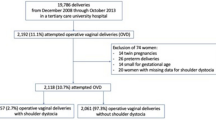Abstract
Background: The study was aimed to compare pregnancies complicated with shoulder dystocia, of patients with and without diabetes mellitus. Methods: A comparison of all singleton, vertex, term deliveries between the years 1988–1999, complicated with shoulder dystocia with and without diabetes mellitus was performed. Statistical analysis was done using receiver operating characteristic curve analysis. Results: Using a receiver operating characteristic curve analysis, the area under the curve for birth weight was 0.92 (95% CI 0.90–0.93). However, for birth weight of 4,000 g the sensitivity was only 56% with specificity of 95%. While comparing shoulder dystocia between patients with (n=38) and without diabetes mellitus (n=207), neonates of the diabetic patients were significantly heavier (mean birth weight 4,244.2±515.1 vs. 4,051.6±389.5; P=0.008) and had higher rate of Apgar scores lower than 7 at 1 min (50.0% vs. 25.9%; P=0.030), but not at 5 min (2.6% vs. 2.0%; P=0.083) when compared to the non-diabetic group. No significant differences were noted regarding perinatal mortality between the groups (0% vs. 4.3%; P=0.362). Conclusions: The newborn of the diabetic mother complicated with shoulder dystocia does not appear to be at an increased risk for perinatal morbidity compared with the newborn of the non-diabetic mother.



Similar content being viewed by others
References
Langer O, Berkus MD, Huff RW, Samueloff A (1991) Shoulder dystocia: should the fetus weighing greater than or equal to 4000 grams be delivered by cesarean section? Am J Obstet Gynecol 165:831–837
Ginsberg NA, Moisidis C (2001) How to predict shoulder dystocia. Am J Obstet Gynecol 184:1427–1430
Christoffersson M, Rydhstroem H (2002) Shoulder dystocia and brachial plexus injury: a population-based study. Gynecol Obstet Invest 53:42–47
McFarland M, Hod M, Piper JM, Xenakis EMJ, Langer O (1995) Are labor abnormalities more common in shoulder dystocia?. Am J Obstet Gynecol 173:1211–1214
O’Leary JA, Leonetti HB (1990) Shoulder dystocia: prevention and treatment. Am J Obstet Gynecol 162:5–9
Sheiner E, Levy A, Hershkovitz R, Hallak M, Hammel R, Katz M, Mazor M (2005) Determining factors associated with shoulder dystocia: a population-based study. Eur J Obstet Gynecol Reprod Biol (in press).
McFarland M, Trylovich CG, Langer O (1998) Anthropometric differences in macrosomic infants of diabetic and nondiabetic mothers. J Matern Fetal Med 7:292–295
Acker DB, Gregory KD, Sachs BP, Friedman EA (1988) Risk factors for Erb-Duchenne palsy. Obstet Gynecol 71:389–392
White P (1978) Classification of obstetric diabetes. Am J Obstet Gynecol 130:228–230
Cedergren MI (2004) Maternal morbid obesity and the risk of adverse pregnancy outcome. Obstet Gynecol 103:219–224
Sheiner E, Levy A, Menes TS, Silverberg D, Katz M, Mazor M (2004) Maternal obesity as an independent risk factor for caesarean delivery. Paediatr Perinat Epidemiol 18:196–201
Jensen DM, Damm P, Sorensen B, Molsted-Pedersen L, Westergaard JG, Ovesen P, Beck-Nielsen H (2003) Pregnancy outcome and prepregnancy body mass index in 2459 glucose-tolerant Danish women. Am J Obstet Gynecol 189:239–244
Wagner RK, Nielsen PE, Gonik B (1999). Shoulder dystocia. Obstet Gynecol Clin North Am 26:371–383
Gilbert WM, Nesbitt TS, Danielsen B (1999) Childbearing beyond age 40: pregnancy outcome in 24,032 cases. Obstet Gynecol 93:9–14
Bianco A, Stone J, Lynch L, Lapinski R, Berkowitz G, Berkowitz RL (1996) Pregnancy outcome at age 40 and older. Obstet Gynecol 87:971–922
Author information
Authors and Affiliations
Corresponding author
Rights and permissions
About this article
Cite this article
Levy, A., Sheiner, E., Hammel, R.D. et al. Shoulder dystocia: a comparison of patients with and without diabetes mellitus. Arch Gynecol Obstet 273, 203–206 (2006). https://doi.org/10.1007/s00404-005-0051-9
Received:
Accepted:
Published:
Issue Date:
DOI: https://doi.org/10.1007/s00404-005-0051-9




